In the bustling digital landscape, where businesses vie for online prominence, the choice between Google Ads and Facebook Ads plays a pivotal role in determining a company’s advertising success. Atomic Leap as Bristol PPC agency is well aware of this, as they guide businesses through the intricate world of pay-per-click advertising. But the burning question remains: which platform should your business prioritize?
However, here’s the catch: businesses must choose their stage wisely. The decision between Google Ads and Facebook Ads holds the key to effective digital advertising. Each platform boasts unique capabilities, making it essential for businesses to align their choice with their specific goals and objectives. As we delve deeper into the world of online advertising, we’ll navigate the intricacies of these giants to help businesses make the right call for their success.
Facebook Ads vs Google Ads
Platform | Facebook ads | Google ads | ||||||||||||||||||||||
Average Cost per Click (CPC) | 97 cents | 1-2 $ | ||||||||||||||||||||||
Average Click-through Rate (CTR) | 1.32% | 4.85% | ||||||||||||||||||||||
Average Cost per 1,000 Impressions, or CPM $11.69 Facebook* $10.41 Instagram* $3.12 Average Cost per Lead (CPL) $10.94 Facebook* $12.78 Instagram* $40.74 Average Click-through Rate (CTR) 0.90% 6.30% Average Conversion Rate 9.21% 7.26% User Intent Passive: Audience may not be actively looking or ready to buy Active: Audience is actively searching and ready to buy Targeting Basis Interests, demographics Keywords, search intent Ad Types Image, Video, Slideshow, Carousel, Collection, and Instant Experience Organic results, Call-only, Shopping Ads, Service Ads, and Remarketing Display Ads |
Differences in Campaign Features
Facebook Ads and Google Ads are two prominent advertising platforms with distinct features and capabilities. Here are some key differences in their campaign features.
Platform | Facebook ads | Google ads |
Advertising Goals | Facebook offers a wide range of ad objectives, including brand awareness, engagement, website traffic, lead generation, and e-commerce sales. | Google is primarily focused on search and display advertising, with goals like driving website traffic, increasing sales, and generating leads. |
Ad Networks | Facebook, Messenger, Instagram, and Audience Network | Google search, display, shopping, remarketing, and local service ads |
Audience Intent | Passive | Active, users with high purchase intent |
Ad Targeting | Audience | Keywors for search campaigns and audience targeting for display campaigns |
Audience Targeting by Location | ✓ | ✓ |
Audience Targeting by Behaviors, Interests, or Demographics | ✓ | ✕ |
Ads With Images | All Ads | Shopping and remarketing |
Video Ads | ✓ | ✕ |
Ad Scheduling | ✓ | ✓ |
Negative Keywords (to Exclude) | ✕ | ✓ |
Automatic Budget Optimization | ✓ | ✓ |
Remarketing Ads | ✓ | ✓ |
When to Use Facebook Ads

Facebook Ads can be a powerful addition to your digital marketing strategy in various scenarios. Here are some situations when you should consider using Facebook Ads:
- Building Brand Awareness: If your primary goal is to introduce your brand to a new audience or reinforce your brand’s presence among your target demographic, Facebook Ads can help by reaching a wide user base.
- Promoting Content: Facebook Ads are an excellent choice when you want to promote blog posts, articles, videos, or other content to a specific audience. This can help increase website traffic, engagement, and brand authority.
- Lead Generation: If you’re looking to collect leads for your business, such as email sign-ups or inquiries, Facebook Ads offer lead generation campaigns that allow users to submit their information directly through the ad.
- Product Sales: E-commerce businesses can benefit from Facebook Ads when looking to boost product sales. You can create dynamic ads that showcase your products to users who have shown interest in them.
- Event Promotion: Whether it’s a webinar, product launch, or in-person event, Facebook Ads are effective in promoting and driving attendance to your events.
- App Installs and Engagement: For mobile app developers, Facebook Ads can be used to promote app installs and engagement. You can target users who are more likely to download and interact with your app.
- Remarketing: Facebook Ads are valuable for retargeting users who have previously visited your website or engaged with your app. You can remind them of your products or services, encouraging them to return and make a purchase.
- Local Business Promotion: If you have a physical store or offer services in specific locations, Facebook Ads can help you reach a local audience. You can even set up ads to drive foot traffic to your store.
- Seasonal Campaigns: During holidays or special occasions, Facebook Ads can help you run targeted campaigns to capitalize on seasonal trends and boost sales.
- Testing and Learning: Facebook Ads provide a cost-effective way to test different ad types, audiences, and strategies. You can gather valuable insights to refine your marketing approach.
In summary, Facebook Ads are versatile and can be used in a range of scenarios to achieve various marketing objectives. It’s essential to align your choice to your specific goals and target audience for the best results.
When to Use Google Ads
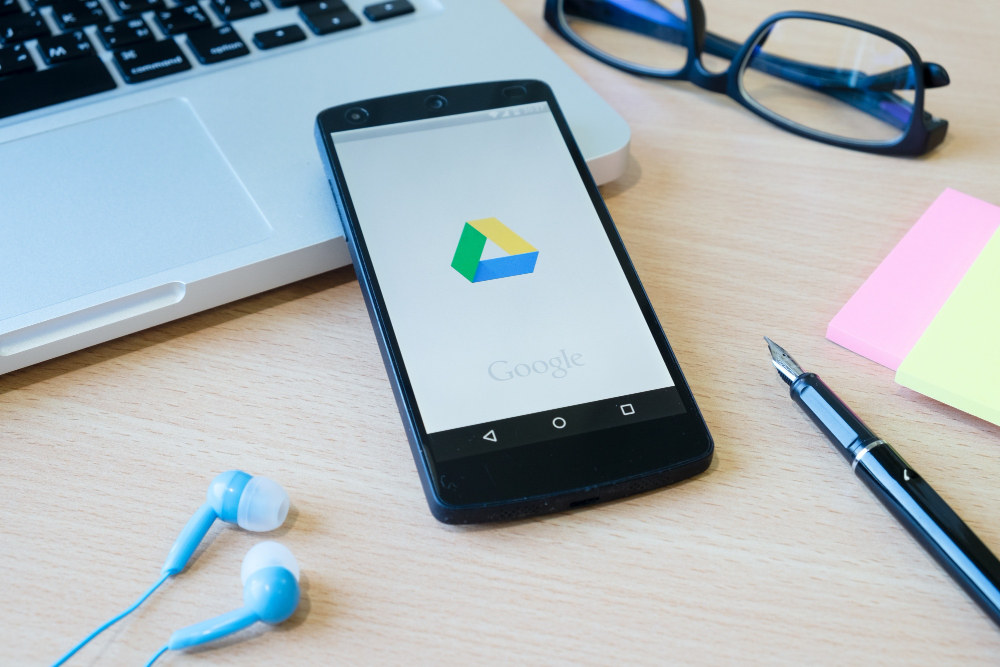
Google Ads is a versatile advertising platform that can be highly effective in various situations. Here are some scenarios in which you should consider using Google Ads:
- Search Intent: Use Google Ads when you want to target users actively searching for specific products, services, or information. Google is the go-to platform for capturing users with high purchase intent.
- Keyword Targeting: Google Ads is ideal for keyword-based targeting. When you have a list of keywords relevant to your business, using Google Ads allows you to bid on those keywords and appear in relevant search results.
- Quick Results: If you need immediate results, Google Ads can provide fast visibility. Your ads can be up and running within a short period, making it suitable for promotions, sales, or urgent marketing needs.
- E-commerce Sales: For online retailers, Google Ads can be an excellent choice for driving e-commerce sales. You can create shopping ads that showcase your products, prices, and availability.
- Local Business Promotion: If you have a physical store or offer services locally, Google Ads can help you target users in your area. It’s especially valuable for attracting foot traffic and driving local sales.
- Remarketing: Google Ads offers powerful remarketing capabilities. You can show targeted ads to users who have visited your website, encouraging them to return and complete a desired action.
- Competitive Advantage: If your competitors are using Google Ads, not using it could put you at a disadvantage. It’s crucial to maintain a presence where your competitors are advertising.
- Seasonal Campaigns: Google Ads is effective for running seasonal campaigns. Whether it’s for holidays, special events, or limited-time promotions, you can reach users at the right moment.
- Lead Generation: Google Ads offers lead generation campaigns that allow users to submit their information directly through the ad. It’s suitable for businesses looking to collect leads and inquiries.
- Specific Audience Targeting: You can refine your audience targeting using various options, including demographics, interests, and more. This precision is valuable for reaching your ideal customers.
- Data-Driven Marketing: Google Ads provides extensive data and analytics, enabling data-driven decision-making and continuous optimization.
- Testing and Learning: Google Ads is an excellent platform for testing different ad types, ad copy, keywords, and bidding strategies. It allows you to gather insights and refine your campaigns over time.
In conclusion, Google Ads is a valuable tool for businesses looking to drive immediate, high-intent traffic, whether you’re focused on sales, lead generation, or local promotions. The key is to align your Google Ads strategy with your specific goals and target audience for optimal results.
Which is better: Google Ads or Facebook Ads?
In summary, the choice between Facebook Ads and Google Ads depends on your specific advertising goals, target audience, and the nature of your products or services. Some businesses benefit from using both platforms to cover different stages of the customer journey and reach a broader audience.
Interested in PPC in Bristol, Paid Social, or both, but not sure how to get started? Hit us up & our PPC & Paid Social team would love to chat with you!
Liked the article? Don’t forget to share it on social networks.

ABOUT THE AUTHOR
Wayland Coles is MD and Founder performance marketing agency Atomic Leap, where he helps businesses of all sizes capitalize on the power of PPC marketing.
LinkedIn: Wayland Cole
When conducting an e-commerce SEO audit, it’s essential to follow a comprehensive e-commerce SEO audit checklist to ensure that your online store is optimized for search engines. An SEO audit for e-commerce site involves reviewing various aspects of your website, from e-commerce SEO technical audit elements to on-page optimizations. Here’s a detailed guide on what to check for during an e-commerce SEO audit:
1. Technical SEO
- Website structure and hierarchy.
- URL structure and permalinks.
- Sitemap and robots.txt file.
- HTTPS implementation.
- Page load speed and performance.
- Mobile-friendliness and responsiveness.
- Schema markup for product pages.
2. On-Page SEO
- Title tags, meta descriptions, and header tags (H1, H2, etc.).
- Keyword optimization in product descriptions.
- Image alt tags.
- Canonical tags for duplicate content.
- Internal linking structure.
3. Content Quality
- Product descriptions: Ensure uniqueness and informativeness.
- Blog content: Relevance and quality.
- User-generated content (reviews and ratings).
4. Product Pages
- Unique product descriptions for each item.
- High-quality images with descriptive alt tags.
- Product reviews and ratings.
- Clear pricing and availability information.
5. User Experience (UX)
- Site navigation and organization.
- Mobile optimization and responsive design.
- Checkout process ease and security.
- Site search functionality.
6. Site Speed
- Page load times across devices.
- Image optimization.
- Minimization of HTTP requests.
- Caching and compression.
7. Technical Issues
- Broken links and 404 errors.
- Redirects (301 and 302 redirects).
- Duplicate content issues.
- Use of structured data (schema markup).
8. Local SEO (if applicable)
- Google My Business profile optimization.
- Local keyword targeting.
9. Backlink Profile
- Quality and relevance of backlinks.
- Toxic or spammy backlinks.
10. Conversion Rate Optimization (CRO)
- Checkout process optimization.
- Calls-to-action (CTAs) and buttons.
- Product page layout and design.
- Abandoned cart recovery strategies.
11. Analytics and Tracking
- Google Analytics and Google Search Console setup.
- Tracking and analyzing user behavior.
- Monitoring key performance metrics.
12. Security
- Regular security audits.
- HTTPS implementation.
- Protection against malware and hacking.
13. International SEO (if applicable)
- Hreflang tags for multiple languages and regions.
- Currency and pricing adjustments.
14. Social Media Integration
- Ensure social sharing and integration options are optimized.
15. Legal Compliance
- Privacy policy, terms and conditions, and other legal requirements.
Conducting an e-commerce SEO audit using this e-commerce SEO audit checklist will help you identify areas for improvement, ensure your website’s SEO health, and boost its visibility in search engine rankings.
What tools can you use to conduct SEO audits?
You have several options when it comes to SEO audits:
- Do It Yourself (DIY): Clients with a good understanding of SEO can perform their own audit using the checklist provided. There are many online resources and tools available to assist in the process. Use a tool like Screaming Frog to highlight any technical errors
- Paid Services: Clients can opt for paid SEO audit services provided by various SEO tools and agencies. These services often offer in-depth analysis and recommendations based on the audit results. There are several you can try. Semrush gives you keywords, competitive analysis, article ideas, and a set of other tools. Then there is Ahrefs or Moz.
- Experienced SEO Marketing Agency: You can turn to an experienced SEO marketing agency to conduct the audit. Such agencies can not only perform the audit but also develop the right SEO strategy, improve the website’s structure, analyze competitors for further promotion, and work on improving the site’s position by increasing targeted traffic within a specified timeframe, often within three months.
By choosing the approach that best suits their needs, you can ensure that you e-commerce website is fully optimized for search engines, driving increased organic traffic and improving their online visibility.
ABOUT THE AUTHOR
Nataliia Yuzhaninova is SEO manager of marketing agency Atomic Leap.
LinkedIn: Nataliia Yuzhaninova
Now is the perfect time to prepare a promotion strategy for the next 12 months. Social media activity is one of the key components of such a strategy. Our paid advertising agency in social networks and PPC has been operating in the market for many years. We always monitor trends in this area and want to share what social media trends are relevant for 2023.
#1 Shopping on Facebook and Instagram remains
Atomic Leap’s experts at PPC in Bristol and the UK are confident that e-commerce and social media will continue to work in tandem.
Back in 2020, Instagram launched the Purchased tab. There, users can immediately see the new products of companies. Facebook encourages merchants to use the built-in storefront and has made it easier to upload products. The trend suggests that this feature will remain and may even be developed.
#2 The future of live shopping is changing
Livestream shopping is one of the online trading formats that is actively developing and gaining popularity. Such marketing activities involve celebrities or influencers who promote the product through live video. The idea itself dates back to before the advent of the Internet, but with new technologies, the format has received a second wind. So how does it work now?
Well, directly below the comment block during broadcasts, links appear to the products that bloggers are demonstrating or discussing. There is also an “add to cart” button.
In addition, back in October 2022, Facebook closed its social commerce network. Instead, their attention and resources have shifted to the further development of Reels video stories.
As before, familiar to everyone, Facebook Live is used to broadcast events. But wait! Now you can’t create product listings and link to them in the videos themselves.
What else has changed? As of March 16, 2023, it is no longer possible to tag items for sale on your Instagram live streams.
Why did these changes take place?
META decided to focus on in-post advertising and its effectiveness. Already in February, the “Purchases” tab was removed from the feed. We can confidently say that shopping on social networks remains a trend. But their format is likely to be simpler and more familiar, with minimal interactive elements.
#3 Persuade and sell in 10 seconds
The time that people can concentrate is decreasing. This means that effective video ad time is reduced from 30 seconds to 10 seconds.
People spend more time on social media, but spend significantly less time viewing each ad.
The average attention span today is just eight seconds! if you are reading this, then you have successfully overcome the trend!
Most companies are already adapting their advertising strategies to the eight second rule.
#4 Use augmented reality more
Over the past five years, search queries related to social media and AR have increased in frequency by 81%. The market for augmented reality (AR) related products and services may still be in its infancy. But the forecasts from experts are amazing. In 2023, the AR sphere will generate £55-60 billion in revenue. And the upward trend will continue.
Social networks are part of this party. Instagram has already jumped into the augmented reality game. Users can invent and create their own filters. Back in October 2022, Meta announced a new way to share content from Horizon Worlds – Meta’s flagship social VR app – to Facebook and Instagram Reels. In addition, they announced a Quest Pro VR headset. Users were promised that they would be able to “join the team and meet inside the Meta Horizon workspaces” in 2023.
That is, just one top technology company fully invested in expanding the possibilities of virtual and augmented reality.
#5 UGC and working with micro-influencers
The demand for more relevant and “authentic” content is constantly growing. This means that brands in 2023 will begin to invest even more in micro-influencers. User-generated content (UGC) will also be in demand. This is done to build and develop a more trusting relationship with the target audience.
Brands that manage to leverage user-generated content (UGC) increase their returning visitors by 20%. They also increase the amount of time potential customers spend on their websites. On average, this indicator grows by 90%.
We are sure you will agree, this is a significant reason to make UGC content part of your strategy in 2023.
#6 Meta strategy: Facebook remains a top product
Facebook remains at the top of the social media hierarchy. It now has over 2.9 billion active users. After the rebranding, Meta plans to dominate the digital world. To a large extent, the emphasis will shift towards virtual reality.
Facebook will not slow down the development of e-commerce features, Facebook stores and Instagram though. Their declared goal is to provide sellers with an easy and convenient way to connect with their audience.
#7 Social media audio
Audio files in social networks are a great tool for direct communication with the audience and collecting feedback. Interest in this content format will grow rapidly going forward. Such content is posted on audio-enabled platforms, such as VoIP systems, to connect the audience via voice chat.
Back in 2021, Facebook launched podcasts, Soundbites and Rooms. The goal of the innovations is to give audio creators more tools to work with. Voice tweets from Twitter and Spaces along with audio events from LinkedIn suggest this trend is just getting started.
An interesting year lies ahead
The year ahead will be very interesting and full of changes. To make your promotional activity more successful, consider the following recommendations:
- Be sure to use analytics. Keeping track of keywords and trending queries on your social networks will help you stay one step ahead of the competition. Instagram, Facebook, TikTok, and YouTube business pages have their own analytics tools—use them to filter hashtags and monitor users to better understand how to communicate with your audience.
- Invest in quality social media management tools. It will help you organise, manage and plan your social media campaigns. Tools like Zoho Social and Hootsuite let you easily manage all your social media platforms in one window. This will allow you to optimise and change your strategy in response to changing social media trends.
- Keep a close eye on your competitors. Understanding how your competitors are doing on social media is a great way to assess the situation and make sure you’re one step ahead.
And, of course, always remember that the specialists at digital marketing agency Atomic Leap will be happy to help your business conquer any social network.
Local SEO is a type of search engine optimisation for small and medium businesses that helps to achieve high positions in the search results for geo-specific queries.
Knowing the trends and optimisation principles associated with local search is now becoming a marketing priority for many types of company. That is why we are going to look at some local SEO tips in a moment.
Types of company optimising for local search
- Stores and companies with a physical sales office
- Cafes, restaurants
- Entertainment establishments
- Medical and cosmetic clinics and we are seeing local SEO for dentists
- Beauty salons
For some projects, why local SEO is important is that it’s the only strategy that guarantees the achievement of marketing objectives. This is because of the following:
- Search personalisation. The first positions in the search results are occupied by larger companies and stores, as well as catalogues and aggregators. This is a big reason why local SEO is important for small business.
- Search service algorithms are adapted to the semantic meaning of the search query, and not to key phrases (keyword).
- Search results are adapted to the location of the user who is looking for a particular product or company. This method allows search engines to provide different answers to the same search query sent from different places, which provide results that are closest to the user.
In this blog, as a local SEO expert we will tell you about the advantages of local SEO and what mechanisms work in local SEO as well as how to optimise a site for local search results; in short, we’ll tell you how to dominate local SEO.
Benefits of local optimisation
Local optimisation allows you to:
- Increase the volume of traffic to the site for local low-frequency queries
- Take conversions to the next level
- Gain an edge over larger competitors in your business sector
- Increase your brand awareness
As you can see, they are all good reasons to prioritise search engine optimisation for local business.
Top ranking factors for local SEO

Search results are becoming more and more personalised. One of the factors of personalisation is the location of the user. Google uses maps and quick replies to show information from companies that are geographically closer to the searcher’s location. So all of the following local SEO ranking factors are important when considering how to improve local SEO.
- The physical address of the company. The closer you are to the user at the time of the search, the higher the probability of getting into their local results.
- Availability of your company in Google My Business, Google Maps, Bing Places with the right category and description.
- Quality link profile is good for local SEO UK.
- Optimised URL, title tags, headers, meta description, and content for geo-requested queries.
- Citation of the brand or mention of the company in local media, forums and blogs.
- Registration in local directories and services helps for local SEO B2B or B2C.
- The same NAP (name, address, phone) for all sites and services where your company is listed.
- Reviews about the company in various sources – their quantity, quality and regularity of writing.
- Behavioural factors. Clicks on the company card, clicks on phone numbers.
- Social signals about the activity of the company in social networks.
Local search result types
There are three types of ranking results for geo-specific queries:
- Local organic results.
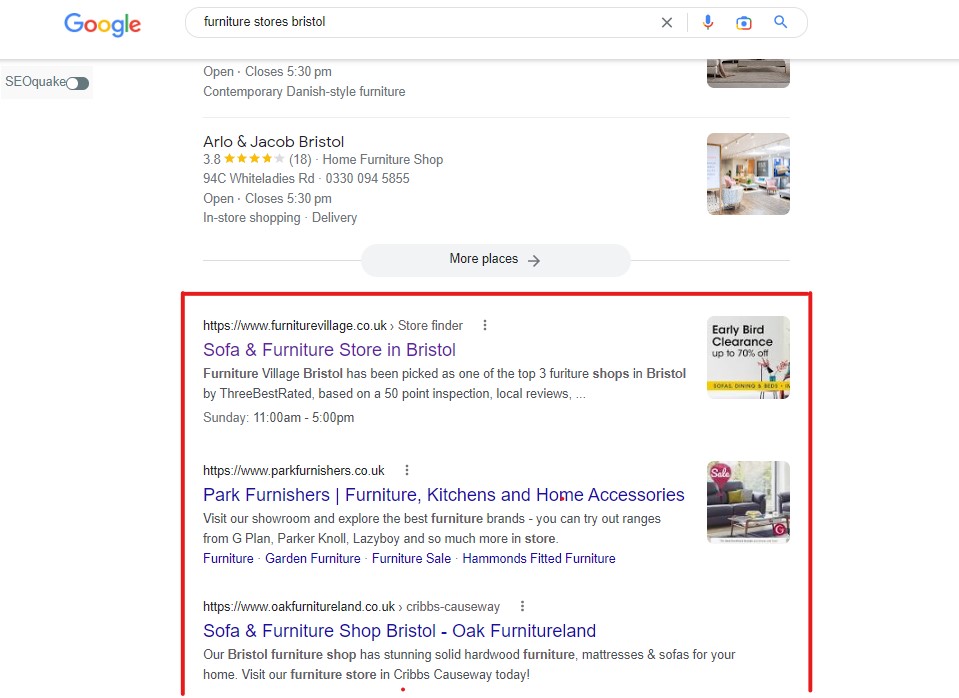
- Google Local Map Pack is the top three results from Google Maps.

- Local Knowledge Graph – usually this is the results for direct queries.
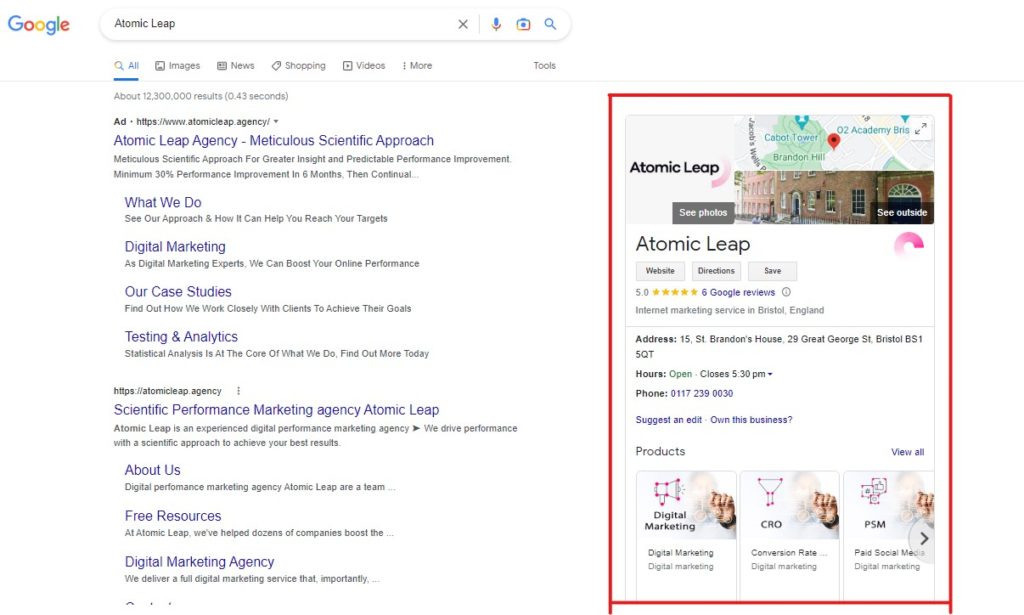
And you can dominate each of these above.
How to improve local SEO and dominate the SERPs

Here are 11 simple but useful tips that we use in our own SEO agency to help you improve your local SEO and make it more relevant to search engines:
- When generating search results for a geo-dependent query, search engines take into account NAP (name, address, phone). Consistent contact information on all sites that provide information about the company will allow search bots to accurately identify your brand.
- List your business on Google with a free Business Profile (formerly Google My Business) and on Bing Places. In addition to the fact that services allow you to get to top positions in the search results, they themselves can be a great source of traffic.
- Work on the contact page on your site and mark it up with semantic tags so that search engines interpret the data correctly. Add microdata LocalBusiness (schema.org) – specify as many properties as possible: from the address and company name to geographic coordinates, opening hours, branches, reviews and links.
- Meta tags like title, description, heading tags H1, H2 should contain the name of the city and/or district where your enterprise is located or operates.
- Work on site content for local keywords. All local queries should have a pronounced geo-dependence and a clear regional intent. Google doesn’t rank websites, it ranks pages. Therefore, you need to create separate landing pages for specific locations, avoiding duplicates of the main content.
- Optimise content for voice search using more long-tail keywords.
- Image optimisation. It is necessary to prescribe the name of the city, district, street in the Alt attribute, which allows for ranking when searching for a product by image.
- Generate as many reviews as possible.
- Publish posts and reviews on social networks, they will increase local brand awareness and attract additional traffic to the site.
- List your business on local business directories such as Yelp, Foursquare, MapQuest, and Yellow Pages. You need to choose the most suitable sites, log in, add information about your business and a link to your website.
- Get high-quality backlinks from regional sites.
Help with local SEO optimisation
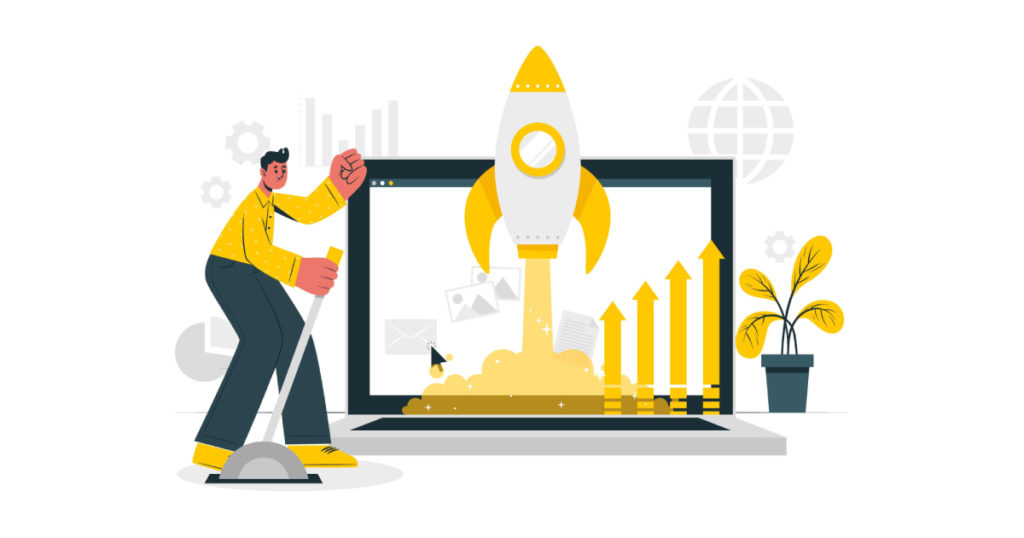
We hope you found that local SEO checklist useful. By following these tips, you will make your website and local business more visible to search engines. If you would like us to manage it all for you though, please do not hesitate to contact our local SEO solutions team and we can tell you more. Or get in touch even if you just have a further question around how to optimise your website for local search. We would love to share our experience in local SEO strategy with you.
If you found this article helpful, share the link with people you know. They might also benefit from knowing about local SEO.
ABOUT THE AUTHOR
Nataliia Yuzhaninova is SEO manager of marketing agency Atomic Leap.
LinkedIn: Nataliia Yuzhaninova
Even at the stage of developing an online store, it is important to devise a strategy for promoting it. And in doing this it is wise to consider an important component of marketing: brand reputation. One of the most proactive ways you can manage reputation is through online reviews and testimonials. But how to collect customer reviews?
In this blog post we will tell you how to get real reviews for your online store. In turn, this will help you attract more loyal customers.
Table of Contents:
Main ways to get feedback for eCommerce sites
How do reviews affect your site?
Main ways to get feedback for eCommerce sites
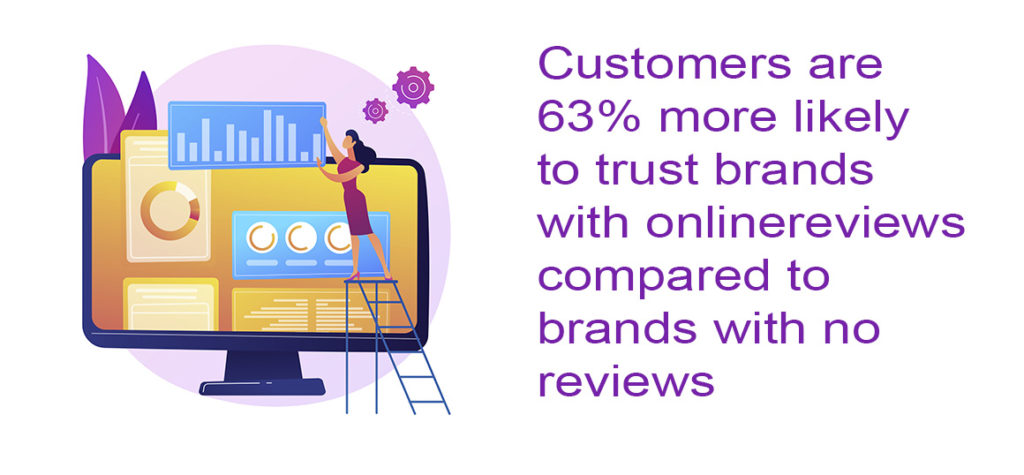
As an SEO digital marketing agency, we have four simple suggestions around reviews, and to strengthen customer loyalty to your brand and online store.
- Raise your authority. Buyers are 63% more likely to trust and buy from a company with good reviews. The store should have a feature that allows you to leave a review.
- Encourage referrals. 84% of shoppers trust business reviews as much as personal recommendations. Offer bonuses for reviews, but don’t be too aggressive. Change your approach to content. Give a huge amount of attention to tweaking the opening email in your mailing list until it is the “right” one? The knock-on effect of engaging people properly at this first stage are significant.
- Help customers use the products. High-quality and informative product reviews not only improve the reputation of the brand. They also help future buyers get the most from their prospective purchases, further fostering good will.
How to motivate customers to leave reviews: 6 proven tool
1. QR code on the package
Providing a QR code facilitates a quick way for your customers to leave feedback. It is easy for them to scan with a smartphone and takes up little space on point of sale (POS) materials. Generate a QR code with a direct link to the desired page for collecting reviews, such as your Google My Business page or another landing page with reviews.
Remember to place the QR code where it is convenient to scan it.
2. Email
A trigger email is one of your best email marketing tools. It is sent in response to a targeted customer action, such as after purchasing a product. But what should you include in your messaging so that the customer wants to leave a review. Here are a few ideas:
- A motivating subject line
- A message from a specific person and a reminder of what the request is for, for instance: “Hi, this is the Super Laptop store team. We want to know if you are satisfied with your recent purchase from us.”
- Include “amplifiers”: These are cues for the client to understand what benefits the survey will bring to them and that it will only take a little time – both important influences.
- A link to your page for collecting reviews, a Google form, a page on social networks or a listing on one of the external sites.
- Gratitude! It is important to express sincere gratitude for any feedback that will be left.
3. Newsletters via messenger or SMS
SMS is a quick way to get in touch with a client who already knows you and made a purchase/order for a service. A more modern version of SMS is instant messenger apps, in particular, WhatsApp.
Send your customer an SMS or WhatsApp message encouraging them to leave a review on the site the next day after buying from your company.
An important point: before sending messages to customers, you need to get their consent to the mailing list. This can be done through the checkout page on the site or through the newsletter subscription form.
4. Remarketing
A non-standard (but effective) option for generating reviews is remarketing. It is relevant for those companies that see great value in the feedback of their customers and are ready to invest an additional budget in this. The ad should target people who have recently bought something from your online store.
5. Compliment from the company
This method increases the number of reviews rather than technically simplifying their collection. If you have the budget, you offer a souvenir product or, for example, clothing with your logo, in return for leaving a review.
6. Competition
One idea to gently encourage those who want to leave a positive review is to arrange a competition on the theme “the best review of the month”. The flow of positive reviews will not take long with this incentive in place.
How do reviews affect your site?

New reviews not only increase the credibility of your online store. They affect other important components of promotion, from search engine optimisation to objection handling and the overall effectiveness of content marketing. Let’s take a closer look at the impact of reviews on all marketing metrics.
- Higher SEO performance. The Google algorithm ranks consumer review pages higher in the SERPs, and user-contributed content is likely to contain keywords.
- Higher click through rate (CTR). You’ll get a featured snippet and rank higher on SERPs if you add star-rated microdata to your website.
- Personalisation of customer experience. Reviews show different points of view on a product and make it easier to choose.
- Reviews supplement information about relevant search queries. Reviews give you insight into the actual keywords your customers are using.
- Help improve products. The experience and opinions of your customers will be a valuable source of information for improving products and services. You don’t need a lot of reviews to take advantage of these benefits. Products are 250% more likely to sell with just five reviews. This should be balanced, however, by one study which found that shoppers want at least 40 reviews to justify an average star rating.
Life hack! What to do if the feedback is negative?
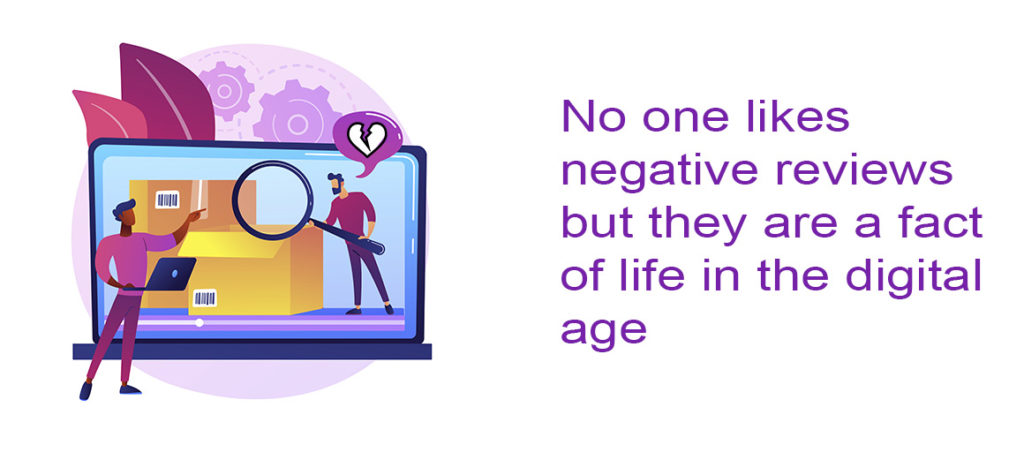
First, it certainly cannot be ignored. In the letter, you can offer to rate the customer experience on a scale from 1 to 10. If the user rates 7 points or lower, redirect them to a form in which they will explain what exactly they did not like and what help they need. You can then respond to this privately.
If the score is between 8 and 10 and the review will therefore be positive, direct the visitor to another form or landing page where they will leave their positive review.
If you receive a negative review on a third-party resource, try to avoid emotions and understand the situation. Criticism shows errors, but it is a tool for correction and improvement. Don’t forget to follow the following rules:
- Be sure to respond to negative reviews.
- Respond quickly. It is better to respond to a negative review quickly so that the author does not write on other sites, and potential customers do not draw the wrong conclusions.
- Do not unsubscribe, but solve the problem. If a customer left a negative review, chances are good that other customers will experience the same.
- Explain your position. Try to calmly and convincingly justify your opinion
On what platforms to collect reviews?

When choosing review platforms, you should prioritise those in the territories where your business operates and those that are affiliated with Google. These are the sites that act as “sources of feedback” for Google in determining reviews and in turn SERP rankings for your business. There are several popular sites where users leave reviews more often than others.
- Google My Business
- Amazon
- Facebook.com
- Yelp
- BBB (Better Business Bureau)
- Yellowpages
- bazaarvoice.com/uk/
- bizrate.co.uk
- feefo.com
- reviews.co.uk
- reevoo.com/en/
- trustedshops.eu
- trustpilot.com
- verified-reviews.co.uk
Positive reviews are an important factor in the health of your Google My Business profile and search visibility for your local business. And this is, therefore, one of the most important considerations in how online reviews affect business.
Get tailored help
As an experienced online performance marketing agency we know that a systematic approach to marketing increases the efficiency of investments in web design and development of an online store. Effective work with reviews will help increase the credibility of your online store and sell more with a higher average bill.
If you are looking for a digital marketing agency in Bristol to help you develop your own tailored review strategy, book a call with us at Atomic Leap and we will help you take your marketing to the next level.
ABOUT THE AUTHOR
Nataliia Yuzhaninova is SEO manager of marketing agency Atomic Leap.
LinkedIn: Nataliia Yuzhaninova
In eCommerce stores, businesses often do not give their product cards the attention they deserve. However, these pages are of significant “strategic” importance.
Let’s take a closer look at these crucial pages and see how you can improve your eCommerce product page optimisation. We will assume your product cards are basically SEO optimised (tags, Title and H1 are written, meta tags are filled in, Schema markup is added) and that they are attracting relevant traffic.
How to make a good product page
With all this done here are further practical recommendations – 15 steps that are worth doing for product page optimisation.
1. Add a “similar products” block
Use product recommendations, bundles (combining products), upsell and cross-sell tools. Even if some products are not suitable for the buyer, they will linger on the site and it sometimes inspires them to choose a suitable alternative option.

2. Post reviews
When considering how to improve product pages, one of the most impactful actions is to include product reviews – 61% of customers read online reviews before buying, and 88% trust website reviews as much as recommendations from close friends and acquaintances.
Having 50 or more product reviews can lead to a 4.6% increase in conversion rates. Therefore, the presence of real comments from buyers is a big step towards increasing trust and profit in the future.

3. Video product reviews
Add video product reviews ranging from 30 seconds to 2 minutes to really bring your products to life.
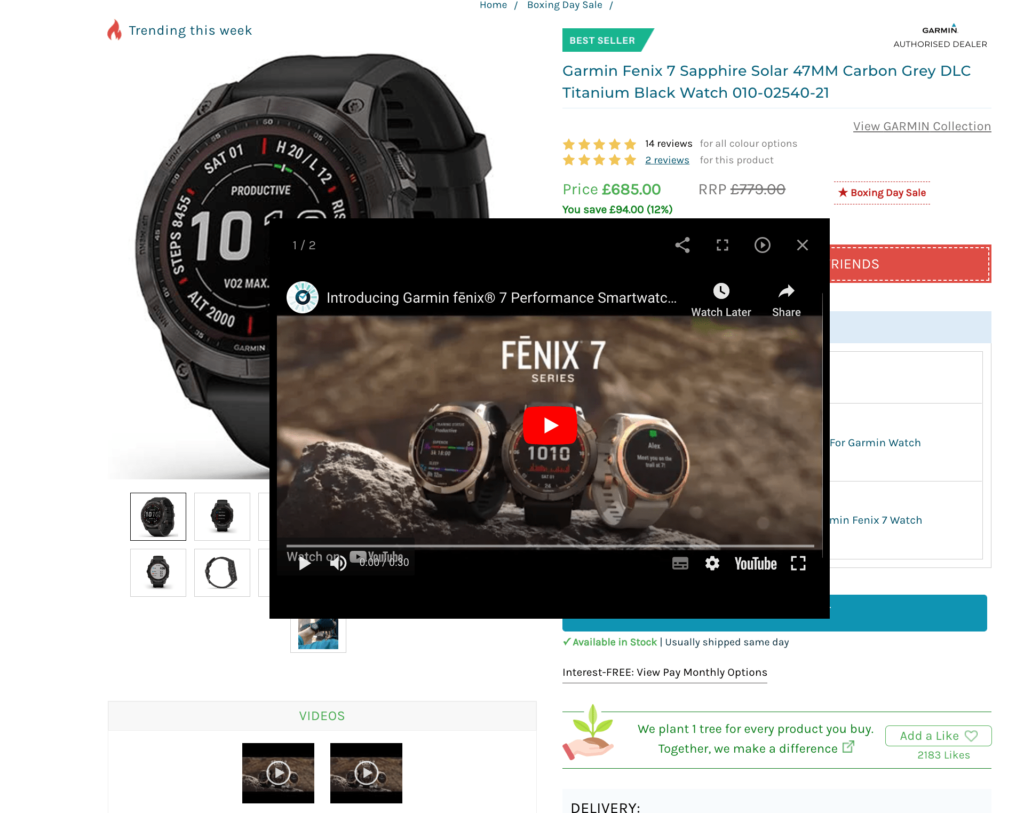
4. Add shipping terms
If you are planning to scale, make it possible for people outside of your city to get an order so you can reach a larger audience, therefore increasing your number of potential buyers. You do not need
to describe all the conditions in detail, for this you have a separate page. But briefly provide basic information.
5. Specify warranties
If you say up front that the product is guaranteed for a certain period, or can be returned or exchanged, it will greatly help to alleviate buyers’ fears, thus making the buying decision easier for them.
6. Add the option “Buy in one click”
If you’re selling locally, the one-click buy option may be right for you. The buyer will not need to fill in many fields, the only thing that needs to be entered is a phone number and name. If trying one-click buying, it is important to test how it works to ensure you give the user a clear understanding of what format the phone number should be entered, in order to avoid user errors.
7. Launch a promotion
When buying, everyone loves discounts, gifts and promotional offers. In addition, it is well-understood that sometimes people buy goods for a promotion, even if they don’t need them or they were going to buy something completely different.
If you specify a discounted price, make it more noticeable than the original one so as not to confuse the buyer.
To make your promotion even more impactful, set a time or quantity restriction, and post the information in a prominent place.
A further benefit of having promotions is that they are great advertising. People like to share special offers with relatives, friends and acquaintances which provides you with more potential leads.
8. Include your product’s features and benefits
If someone sees an empty product card they are likely to leave your site. It is important for buyers to get a detailed description: specs, features, benefits, user-warnings, usability, details, and so on.
The more questions you answer in the buyer’s mind, the more likely they will place an order.
9.Get great product photos
Since you cannot see or touch a product when buying online, photograph (and video) are the primary ways for shoppers to understand it visually.
The quality of imagery does improve the conversion of an online store. Pictures should be clear and detailed, with natural colours, and show different angles. This will help visitors to correctly form an opinion about the product and buy what’s right for them.
We advise including at least three product photos. These should include front, back and side, and have a hand or familiar object in shot so that customers can estimate the dimensions. If the product comes in different forms also show folded, unfolded, installed, and so on.
10. Add symbols of benefit to the consumer on the product page
You could show these benefits as badges or icons for extra visual impact. For example, a promotion, a percentage discount, top sales etc. Your goal is to convince shoppers that their search is complete and they have found the product for them.
Thoughtful marketing will show your customers that you are the best option.
11. Well-designed CTA and pop-up forms
The call to action (CTA) on the button should accurately reflect the action that will happen when clicked. Your goal is to get site visitors to make a purchase as simply as possible, so guide them through their journey seamlessly.
12. Buy button
Make it bright, contrasting with the content of the product card so that customers don’t have to waste a second searching for it.
13. Add an exit-intent clause
If visitors to your site are not interested in a particular product and want to close the page within 30 seconds, give them options to stay on your site and find something more relevant to them.
14. Page design
Compare your page design with similar competitor pages. This will help you understand if you are keeping up with the latest trends or if your design is outdated. Perhaps it is time for a redesign of your online store from a web design agency for ecommerce projects.
15. Quicken page speed
Fast-loading web pages improve user experience and SEO performance, reducing the number of bounces and moving people towards making their purchasing decisions more quickly.
If you want an SEO audit of an online store, online store promotion, conversion optimisation or Google shopping optimisation, contact us and we will be happy to review your business. We will share our successful cases and select the best integrated solution for you for optimising product pages.
Common mistakes to avoid when you optimise product pages
- Don’t use product descriptions from the manufacturer’s website. Very often, online stores copy text from the manufacturer for product descriptions, publishing them exactly as they are presented on the manufacturer’s website. Many sellers and distributors do this, making the content less unique. It risks sanctions from search engines too.
- The page is not SEO optimised. For an online store, the product card page is your main point of traffic and sales growth. The product card can be optimised for low-frequency queries and high-conversion queries. Read our article on how to optimise a page for SEO.
- Don’t delete product pages that are out of stock. Just hide the product from users, indicate when the product will be in stock and offer an option for alternative products.
- Don’t delete seasonal items. It is best not to remove seasonal products that have managed to take top positions, so that you can maintain their success for the next season. You can hide seasonal products for users on the site, but don’t stop the page from indexing.
Need more information on how to optimise your product pages for more sales?
While there are many good practices to follow to optimise product pages, every business is unique. So analyse your customers to understand what is important for them when choosing a product and how to make this process as convenient as possible.
Your objective should be to make an online experience so good that customers do not want to leave before purchasing. And furthermore recommend you to their friends. This will help your conversion to continually grow.
At Atomic Leap, we are always on hand if you want to discuss your online store with an expert.
Liked the article? Don’t forget to share on social networks.
An abandoned cart is the loss of a customer during the checkout process in an online store. This is a fairly common situation, and one to actively manage as you are so close to converting a sale. So if you are asking “Why do I have so many abandoned carts?”, read on.
In this article we will answer questions like “Why do customers abandon carts?” and “How to avoid cart abandonment?”. But first we will look at cart abandonment rate.
How to calculate cart abandonment rate?
Cart abandonment rate (CAR) is the percentage of users who add a product to their cart and then leave it without placing an order. CAR is calculated using the formula:
(1 – (number of successful transactions / number of cart additions)) * 100%
Let’s say your store generated 500 sales in a month. And the number of times an item was added to the cart without a sale being completed is 2,500. So, using the above calculation, we get a cart abandonment rate of 80%. The average eCommerce cart abandonment rate is around 70-80%, and for some sectors it stretches to 65-85%. Despite the daunting figures, this problem can and should be worked on.
Cart abandonment rate statistics 2022
Research by Baymard Institute shows the average cart abandonment rate differs by industry and devices.
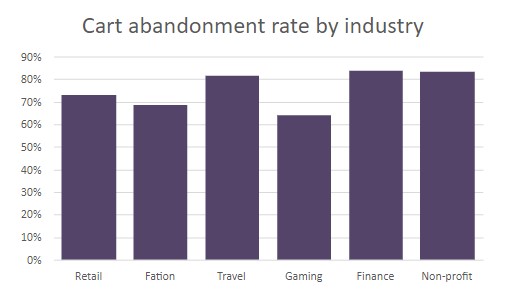
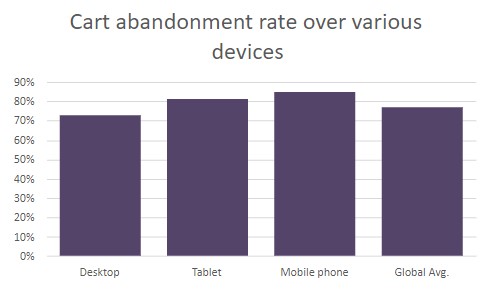
How to check abandoned cart in Google Analytics
If you have enhanced eCommerce Tracking enabled, you can track abandoned carts through the Conversions > Goals > Funnel Visualisation. You should see a report for the different stages of your customer’s on-site journey for the time period you selected. When you navigate to Conversions > Goals > Overview the default goal option is ‘all goals’ you see is Total Abandonment Rate
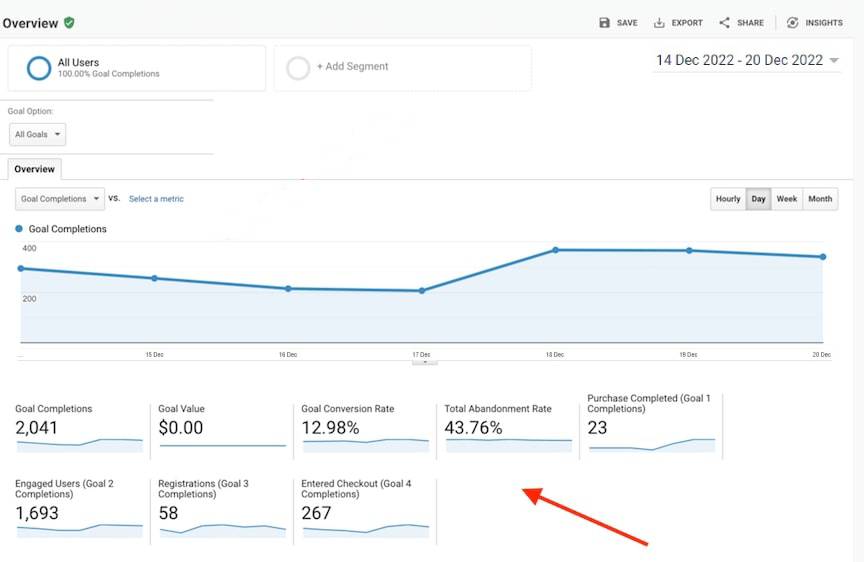
How to check cart abandonment rate in Google Analytics 4
To see how many people leave their shopping carts without buying the products Google Analytics 4 head to the Explore tab > choose to start a Funnel exploration report.

Top 10 reasons why people abandon shopping carts 2022
As part of a survey looking at the reasons for checkout abandonment, the Baymard Institute questioned 4,500 Americans. They were asked: What prompted you to abandon a purchase after you added items to your shopping cart?
- Extra costs too high – 48%
- The site wanted me to create an account – 24%
- Delivery was too slow – 22%
- I didn’t trust the site with my credit card information – 18%
- Too long or complicated checkout process- 17%
- I couldn’t see or calculated total order cost up-front- 16%
- Website had errors -13%
- Returns policy wasn’t satisfactory- 12%
- There weren’t enough payment methods – 9%
- The credit card was declined – 4%
You can see the results of the survey on the graph.
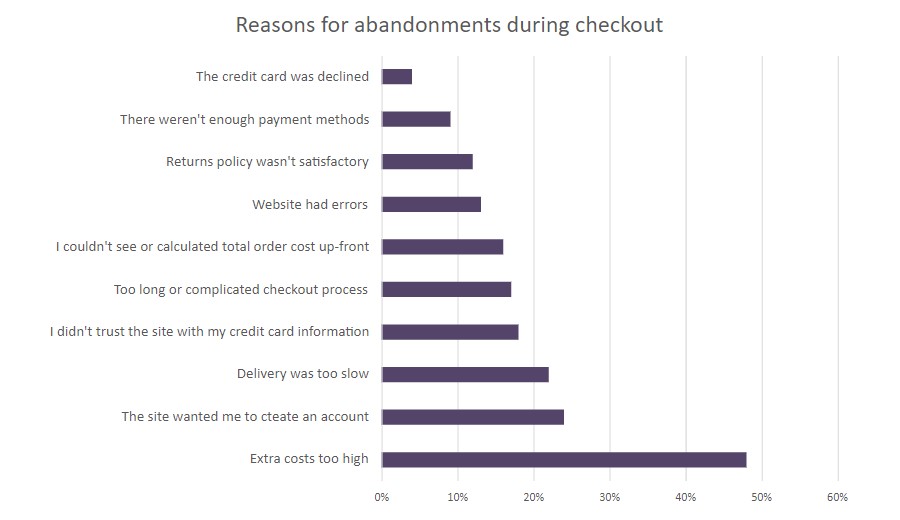
How to decrease your shopping carts abandonment rate in 2023
For 12 years, Atomic Leap has been optimising bounce rates, conversion rates, promoting search engines and advertising online stores across many industries. Based on our experience gained, we will list the eight main reasons why users abandon carts. But more importantly, we’ll tell you how to counter them and therefore how to decrease cart abandonment.
Marketing techniques to combat cart abandonment
| Problems | Solutions |
|---|---|
| High price | If your product is identical or similar to a product offered by your competitors, people will base their selection on price. If your price is the best, say so (but if you’re talking about it, it better be true!). If you can’t beat the price, offer some other added value. |
| Cost of delivery. Does your site have free shipping? | Try to offer free shipping. If this is not possible, then give the customer a set of actions to make the order process more valuable to you. For example, be inspired by iHerb online stores: When a customer looks in their shopping cart, ask them to register some basic details – just two fields: a name and a phone number. This gives you a means to contact them should they abandon. You can then try to follow up and close the sale at which point you can also attempt to collect any other information you need. |
| Doubts. Will this product suit me? Can I return it? | Use live chat or chatbot service to solve customer problems and answer their questions. Create a solid refund and return policy. |
| Insufficient popularity of your company among the target audience. | Add social proof signals, reviews, replace stock photos with studio ones, add a video review, develop an About page. |
| No choice of payment/delivery | The fewer options your user has to pay and receive the goods, the higher the probability of cart abandonment. Make sure that customers can pay and take delivery of products or services in a variety of ways appropriate to what you sell. Amongst some of the most popular payment methods are: Shopping apps (Shop Pay and PayPal) Digital wallets (Apple Pay, Samsung Pay, and Google Pay) Buy now, pay later (Shop Pay Installments, Klarna, Four, and AfterPay) |
| Checkout is challenging | You are requesting too much data from your users which is putting them off. Checkout cptimization can increase conversions by 35.62%. See how you can simplify the buying process to reduce cart abandonment and provide guest checkout options or show customer support contact info during the checkout process. |
| Unable to identify problem areas | Collect customer feedback about pain points. Generate hypotheses and test them with A/B testing.When running A/B tests, you should alter only one variable at a time, so you can identify what impacts the performance of the new campaign. |
| Visitors are not motivated to complete the purchase | Display any deals, applied discounts, or sale prices in your visitors’ cart. Allow customers to save their cart. |
Technical Solutions to reduce abandon carts
| Problems | Solutions |
|---|---|
| Slow site | Make your web pages fast on all devices. Analyze with PageSpeed Insights. Get your PageSpeed score and use PageSpeed suggestions to make your web site fasterl. |
| Lack of responsive layout | A responsive website is one which changes its layout automatically depending on the screen size it is being viewed on. If someone is ordering on their mobile when out, and your website is not displaying properly it is a recipe for cart abandonment. Check your site for adaptability and cross-browser compatibility. Make sure that all key information is clearly visible on all the main platforms. |
6 effective tools to return users to abandoned carts in 2023
There are several tools that can help you recover abandoned carts and bring customers back to your online store. These tools will most likely not be new to you, but take a look below to refresh you knowledge. Results for 2022, based on the performance of Atomic Leap clients.
Exit-intent overlays
Exit intent overlays with surveys can increase conversions by 23% in a product category.
Creating an exit-intent offer that will be shown to a potential customer who, while on the checkout page, suddenly heads to the exit is a good technique. You can again grab their attention with a targeted offer that pops up to encourage them to complete their checkout. You could use time-limited offers, gifts, or attractive discounts and promotions.Cart Recovery Pop-ups
Cart abandonment popups have a 17.12% average conversion rate.
It is used for both mobiles as well as desktop users. WebPush notifications will work in some circumstances. If the user agrees to receive them (the consent pop-up usually appears after they enter the site), you will be able to communicate with them via short messages, sending notifications directly to their PC or mobile.SMS messages
Abandoned cart SMS messages work very well if you have customers’ phone numbers. They usually convert even better than emails, because their open rate reaches 98%. Therefore, if you collect phone numbers, use this functionality to get people to return.
Retargeting
3 out of 4 consumers now notice retargeted Ads, over a quarter (26%) will click on the retargeted ad and return to your site. Retargeting can reduce cart abandonment by 6.5%.
Cart abandonment is a good reason to use retargeting. Place a Facebook or Google Analytics pixel on your checkout page and then you can send customised ads to cart abandoners. To get the most out of your ads:- Segment customers by any key indicator.
- When creating advertisements, add clear and understandable calls to action.
- Test different ad copy and design options.
Abandoned Cart Emails
Cart abandonment emails had a 41.09% open rate in 2022.
An effective way to reduce the number of abandoned carts is to follow up with users by sending emails or SMS. Many eCommerce platforms such as Magento, Shopify, 3DCart, and Volusion offer integrated cart abandonment solutions. Do abandoned cart emails work? Let’s take a look.How long to wait to send abandoned cart emails?
“How many abandoned cart emails should I send?” you are probably asking. The first abandoned cart email should be sent within 10-30 minutes of cart abandonment. Don’t delay. Abandoned cart emails sent within one hour of abandonment have an excellent conversion rate (20.3%). Second emails sent within 24 hours of the bounce can also lead to higher conversions (17.7%). And a third email should be sent within 72 hours.
Personalized Recommendations
Personalized product recommendations can improve cart abandonment by up to 4.35%.
By using customer data and machine learning algorithms, some tools can provide personalized product recommendations to customers who have abandoned their cart, potentially leading them back to your website to complete their purchase.
It’s important to test different approaches and find out what works best for your business. The purchase rate of campaigns using three or more channels is 287% higher than single-channel campaigns.
How to get even better results from your online store
If, after having a go at optimising your cart abandonment rate, you want to scale your business, you can ask us at Atomic Leap to set up online store integration with Facebook and Instagram. This solution will not only increase the popularity of your store and attract new visitors, but also increase sales. We can also discuss with you bespoke ways for how to improve cart abandonment rate.

ABOUT THE AUTHOR
Wayland Coles is MD and Founder performance marketing agency Atomic Leap, where he helps businesses of all sizes capitalize on the power of PPC marketing.
LinkedIn: Wayland Cole
Website traffic from mobile devices is steadily increasing – a phenomenon which experts consider to be quite natural. If you have noticed a decrease in conversion on your mobile site compared to desktop, one reason could be clunky navigation, which, even after adaption, does not fully satisfy user experience.
Research shows that 52% of users prefer smartphones to access the Internet. If you want to increase the conversion of your online store, here are eight steps you could take to create a flawless mobile version of your website.
How to Calculate Mobile Conversion Rate
When deciding to address mobile conversion rate optimisation, calculating mobile conversion rate is quite simple. You use this formula:
Conversion Rate = (Mobile Conversions / Total Mobile Visitors) * 100%
You can easily get all this data from Google Analytics.
For example, if 15,683 visitors visited your website in the last two months and 432 of them converted, the conversion rate for those two months is 2.75%.
8 Proven Ways to Increase Your Mobile Conversion Rate
Here at Atomic Leap Agency, we have not only prepared a selection of proven methods for conversion rate optimisation (CRO) for you; but also, for ease of implementation, we have categorised them by which page(s) they can be applied on your website.
All our suggestions below are based on analysis of user interactions with sites using Google Analytics. If you follow them you are sure to improve your mobile ecommerce conversion rate:
- For the whole site: Adaptation of the site for mobile devices
- All pages of the site: Readability
- All pages of the site: Use lazy loading
- For the catalogue page: Place products in two columns
- For the catalogue page: Optimise the filter
- For the product page: Make sticky CTA buttons
- For the product page: Image optimisation
- For your checkout page: Checkout Optimisation
For the whole site: Adaptation of the site for mobile devices
In order not to lose a significant volume of potential customers, check:
- How pictures are displayed and whether they load at all;
- Whether text or other elements overlay each other;
- If basic information is visible;
- Whether it is possible to place an order, and how convenient it is;
- How fast pages load.
To understand where to focus your attention, analyse what information the client needs to see in order to make a decision. Once you understand this and put it in place, go further and work on your appeal: it should be clear, noticeable, persuasive and convincing.
When you are up to speed, it is really important to regularly (at least once a month) check how the site is displayed on the screen of mobile devices.
All pages of the site: Readability
Pay special attention to this issue. Most e-commerce brands may have experienced problems with readability on their mobile websites at some point.
On the Enhancements tab in Google Search Console, check if you have the “Text is too small to read” error. If so, then the readability of your mobile site is to blame. The ideal font size for mobile screens is 16 pixels.
All pages of the site: Use lazy loading
For long directories with many graphic elements, use the technique of post-loading out-of-scope images. That is, pictures that change automatically or load immediately on the desktop version of your site will load on your mobile site only when the page is scrolled.
The advantages of lazy loading include:
- Saving traffic;
- Increasing the speed of opening pages;
- Reducing the load on the server.
For the catalogue page: Place products in two columns
For the desktop version of your online store, we recommend placing four to five product cards in a row. But for the mobile version, our recommendation is two in a row. This combination is most beneficial in terms of psychology and ease of scrolling.
For the catalogue page: Optimise the filter
Reduce the number of filters so that you only have most relevant and frequently used ones, such as price range slider, size, type, brand flags, and colour. You can enable additional filters if necessary once you have analysed customer behaviour and studied analytics data.
For the product card: Make sticky CTA buttons
In the mobile version of your site, it is important that the call to purchase button is constantly in sight. To do this, use static buttons that appear immediately upon entering the catalogue and accompany the buyer while surfing through the pages.
For a product card (product page): Image optimisation
Optimise the quality of images displayed on mobile devices. You can easily resize and optimise website images with apps like TinyIMG, TinyJPG and iLoveIMG. Some of these apps offer bulk upload so you can process multiple images in one go.
For your checkout page: Checkout Optimisation
It is good practice to reduce the number of steps in the checkout process, reduce the number of form fields, add a checkout progress bar and offer one-click payment. In the fields to fill out, write an example of correct data entry and add a check.
Don’t get left out
Mobile e-commerce continues to grow, and you can’t afford to be left out. It will not be easy to implement the above steps to increase the conversion of the mobile version of the online store website on your own, but the time and effort spent will fully justify itself.
Equally, if you use a performance marketing agency like Atomic Leap the investment you make in our services will more than be returned in improved conversion rate optimisation.
Liked the article? Don’t forget to share it on social networks.

ABOUT THE AUTHOR
Wayland Coles is MD and Founder performance marketing agency Atomic Leap, where he helps businesses of all sizes capitalize on the power of PPC marketing.
LinkedIn: Wayland Cole
Why you need a thank you page?
If you are asking yourself “What is a thank you page?”, then at its most basic level, the main function is to confirm the action that the user has just taken: “Thank you for subscribing!” or “Your order is confirmed!”
But is that all? No way! If you just use a simple: “Thank you for subscribing” you are missing a big opportunity to connect with your website user.
Your thank you page should engage, inspire, and evoke a response or action. It should give people a sense of satisfaction and invite further interaction with your brand. Achieve this and improved conversion rate optimisation is sure to follow.
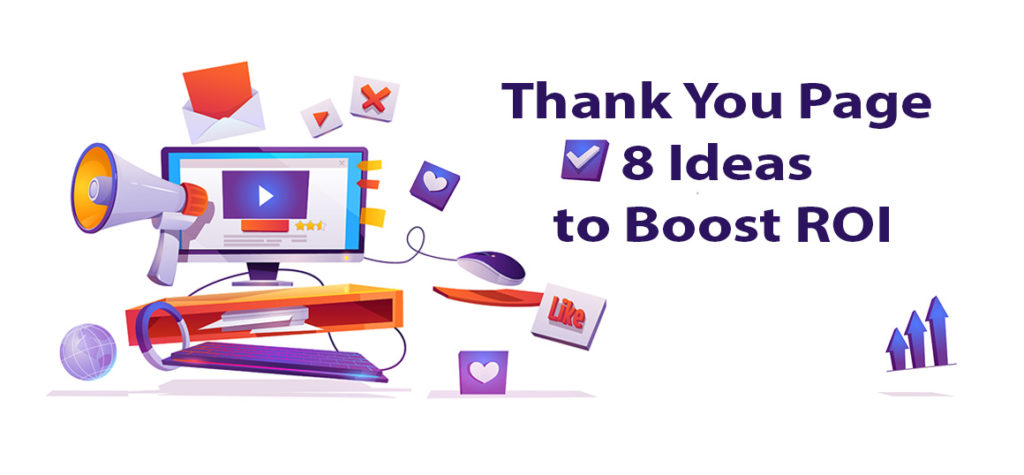
Effective ways to use thank you pages
- Promoting related products.
- The surprise bonus.
- Give them the chance to leave feedback.
- More traffic for useful content.
- Invite users to your social networks.
- Share purchases.
- Collect more data.
- Bonus for a friend.
Promoting related products

Show the user other products that complement the purchase. They are in a buying mindset, so if you make a logical additional proposition to them you will often make an extra sale. It is a tried and tested marketing technique, but when you do it ensure you maintain a sense of proportion: keep the suggestions related to the initial purchase. If it looks like an unrelated, cheap sales tactic you may start to harm your brand.
The surprise bonus
To enhance your brand, why not give a new customer a discount if they go on to make a repeat purchase? Or even give them something extra for nothing (except their good favour). It doesn’t have to be expensive; the main thing here is the element of surprise. By breaking the pattern – offering a bonus after the purchase – you will exceed client expectations. And the positive effect will be much stronger!

Give them the chance to leave feedback

On the thank you page, you can also ask the buyer to leave a review about the service or the purchase itself. Sending a message with a link to the thank you page can be configured with a delay to allow them time to use the product first, if necessary.
More traffic for useful content
If, in addition to cool products, your site has quality content (reviews, insights etc.), offer links to these on the thank you page. It could be a collection of materials about related products, or helpful information about popular and hot offers. Whatever it is, it will be perceived as useful information by your customers, as well as keeping them engaged with your website and fuelling future purchases.

Invite users to your social networks

The thank you page is a great place to encourage visitors to subscribe to your company’s pages on social networks. Be persuasive: tell them that by subscribing they will hear of your latest innovations and the most generous promotions and discounts. They’ll love it, you can be sure!
Share purchases
Whether it is smart new clothes or the latest tech, tap into your customers’ positive feelings associated with their purchase. You can generate more sales by including refer to share purchases.
The mechanics should be as simple as possible. You want your buyer to be able to share news of their purchase within a couple of clicks. Even if the function is used by only five or ten percent of buyers, you are drumming up priceless advertising for your online store from the credible source of an existing customer.

Collect more data

The thank you page can also be used as a source of new data about your customers. Ask them three to five simple questions, advising them in advance that the response process will only take a couple of minutes. You could ask your customer about their preferences, the products that they would like to see on your online store, your service, the site, your company – whatever is useful information to you.
Bonus for a friend
An enhanced referral programme can turbo charge your revenue. The idea is simple and you are sure to have come across it before. Rather than just encouraging an existing customer to talk about their purchases to friends, incentivise them and the recipient to engage. You could offer your customer and their friends additional value: a coupon, a discount code, free samples, additional usage time, credit or valuable content – whichever is right for your business. There is nothing like a freebie, or special offer to get people talking about a product.

Get a better thank you page
As a performance marketing agency, we know that each of these eight thank you page design tips will help you get to know your audience better, drive more traffic to specific pages, or solve other targeted tasks.
Bear in mind, though, that it is not necessary to use all eight recommendations. Choose the ones that are most appropriate to your ecommerce store. Whichever ones you choose, you will notice the impact: more customers for your online business.
ABOUT THE AUTHOR
Nataliia Yuzhaninova is SEO manager of marketing agency Atomic Leap.
LinkedIn: Nataliia Yuzhaninova
One of the key marketing goals for any company is to gain customer trust. This rarely happens by accident. There are specific proven techniques for building trust that a performance marketing agency like us is expert in. Let’s take a look at what they are in more detail.
What is the pyramid of trust and how does it work?

We’ll start by exploring a concept called the Pyramid of Trust.
This pyramid consists of five levels. It is a marketer’s job to lead website visitors higher through each of these stages as trust is built. Each level corresponds to certain buyer needs. Once they are satisfied, the visitor moves to the next level of trust.
| Trust level | Questions from visitors |
|---|---|
| The visitor does not trust the site | Can this site help you achieve a goal or solve a problem? |
| The visitor prefers other sites | Does it make sense to choose this site to solve your problem? Is this resource really better than others? |
| The visitor trusts the site and transfers personal information | Is this site valuable enough to take the time to sign up? Will I trust this site with my data (name, e-mail, phone)? Do I want to receive emails from the company? |
| Visitor provides financial information | Should I trust this site with my confidential data (bank card number, address, etc.)? Is it worth the risk? |
| The visitor has strong trust in the site | Am I comfortable enough to interact with this site on a consistent basis? |
Balance Site’s Demands and Users’ Trust Needs. The site’s requests and the users’ trust needs must be in equilibrium: Don’t make demands at higher levels of commitment until you’ve addressed all the trust needs at the inferior levels.
How to increase the level of trust in your site?
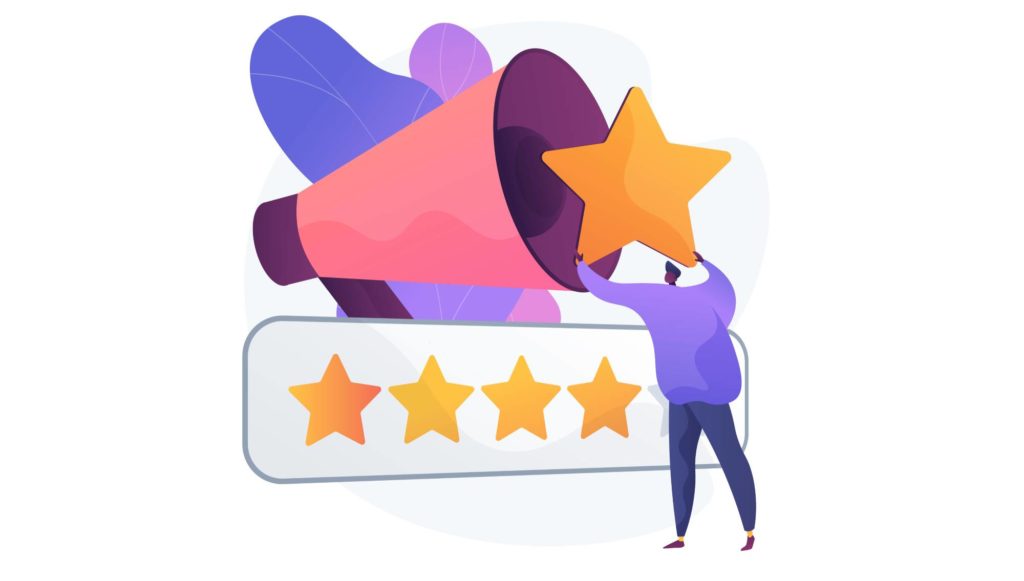
We have seen how trust is gained in general terms and what stages someone may go through. Now let’s look at specific actions that will help your website visitors move from the first step of the pyramid to its top, ultimately with the goal of improving your conversion rate optimisation and sales.
There are universal factors that build trust. As you are reading this, consider how well they are currently working for your site.

Good design
Attractive aesthetics will show visitors that your company has spent resources on developing your website. This will help to inspire confidence by showing your commitment to the market you are operating in. If you can spark a positive emotional response to the design it may even make visitors more tolerant should there be any clunky user experience issues.
Pay attention to the font, colours, logo, etc. By association, all these elements go towards conveying the quality of your products.
Colour scheme
The choice of colour scheme for the site is important for a visitor’s perception of your business value. Colour is part of your branding, signalling where you are positioned in the market, be that among the market leaders, in a premium segment or offering great value. If you have a well-thought-out brand strategy, the colours selected for your website will have a consistency with your products or services.


Website content and navigation
An important element in building visitor trust is to ensure your site is perceived as professional. Well composed and structured content helps keep users on the site and encourages them to spend time familiarising themselves with your goods or services.
Content that contains typos, broken links, and other problems quickly reduces a site’s credibility. Content is not only text, it is also graphics and other visual elements.
Openness and completeness of information
Whether online or through in-person channels, no-one would trust a person or company that hides something important from them. So it is important for visitors on your website to see complete information about goods, services and your company itself. They do not want to be left guessing or to find there was some hidden catch after they have bought something from you.


Contact information
It is important to provide up-to-date contact information and offer multiple channels of communication to reassure customers that they can get hold of you when necessary. It is even better for establishing trust if your company has a physical address to reinforce its online presence. The phone number is one of the key trust factors. It’s a good idea to include a phone number in the header and footer of your site.
Additional formal elements of trust
There are many other formal elements of trust that build credibility with your visitors. These include national licences or official accreditations (where applicable), social widgets and independently verified customer reviews.


Page speed
Most visitors will leave a slow site within ten seconds if pages take too long to load. Search engines also lower slow sites in the SERPs (search engine results pages). As a performance marketing agency, we see fast loading of website pages as being important for the reputation of a business as well as the SEO performance of its website.
For this reason, for example, the sites developed by us are loaded on average in 300 milliseconds. When it comes to site speed, the quicker the better; but at the very least try to keep the download times to no more than three to four seconds.
Company case studies
Detailed, energetic, interesting and accurate case studies are a powerful tool in helping to win the trust of customers. Case studies demonstrate the professionalism of your company and how you use your capabilities to overcome the challenges that your customers face.

Recommendations for the product page of an online store
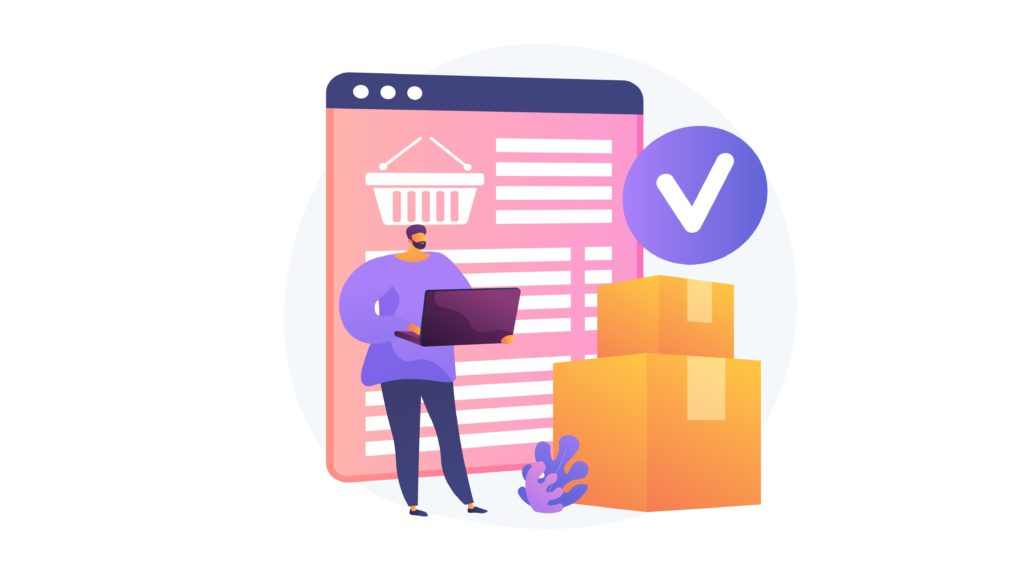
Separately, we need to talk about trust in online stores. This will have a significant impact on your conversion rate and the number of sales.
So let’s talk about the main trust factors in e-commerce and how to work with them to improve conversion rate optimisation.

Reviews
Users trust external sources more than content on a company website. To benefit from this, connect reviews from third-party resources. Also consider adding video reviews if possible – they inspire much more confidence.
Video
Nowadays it is almost always a must to add product videos. Show how the product is packaged, what it comes with and so on. If we are talking about technology, demonstrate its launch, configuration and operation to bring something that may otherwise be intangible to life.


Calls to action
Look at the calls to action (CTAs) on your site. What role do they play? How effective are they? You can estimate their click-through rate using Google Analytics. If any of your CTAs aren’t working as effectively as they might, the good news is that you can experiment to get better results: try changing the location, button colour, and wording for example. With A/B testing functionality, you can find out which CTAs increase your conversions and reduce bounce giving you a vital competitive advantage.
Quality customer service
Think about how you can apply principles of good customer service on your website to improve sales; for example, providing all relevant information that a visitor may seek. If buyers can’t find information that’s important to them, they’re more likely to go to competitors.
Don’t let this happen! Use an online consultant or chat bot to answer customer questions in real time. In addition, create an FAQ section – answers to frequently asked questions from visitors. Answering frequently asked questions from people thinking of buying from you will increase their time on the site and your chances of making a sale.


Payment security
Paying due heed to financial security and data protection is essential for yours and your customer’s sakes. Take care to connect an SSL certificate to the site. This will not only help protect the security of payments and the safety of customers’ financial information, but also send a positive signal to people who are wondering whether to buy from you.
External trust factors
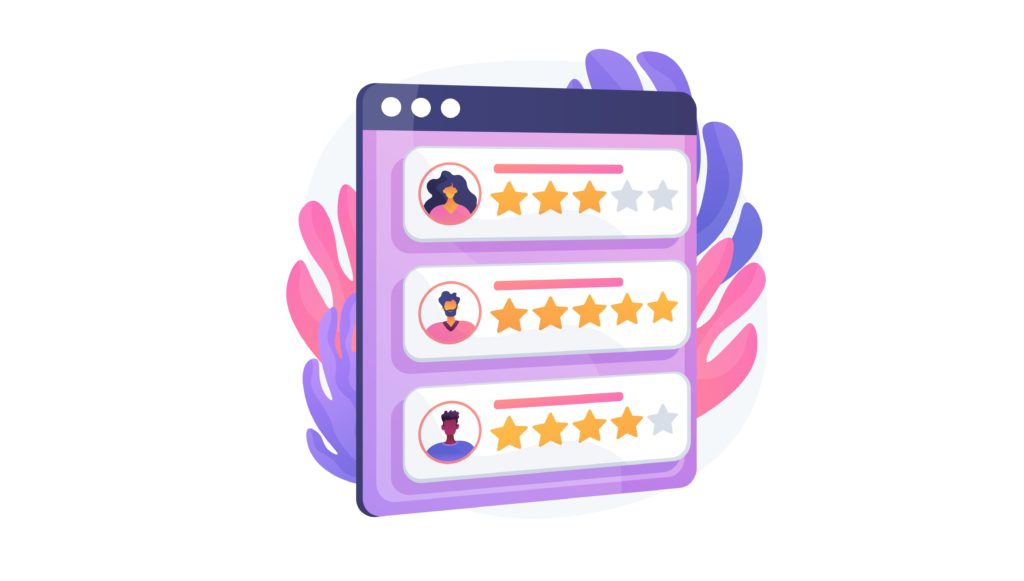
Of course, your website is not the only source of information about your company. You need to pay attention to external sites too, the credibility of your business depends on it.
Here are examples of some types of site where information about your company may be posted:
- Profile aggregators. For almost every business, many resources have been created that combine information about companies, say in a particular city or country. They usually don’t charge for adding minimal information about a new company. But if you want to be top of their lists for searches or to have better functionality to create an attractive profile, you will have to pay.
- Social networks. You are sure to be familiar with the main ones – LinkedIn, Facebook, Instagram… as well as more niche platforms. Important signals of trust on such networks include your number of subscribers, profile activity, as well as the design of the page and the regularity of publications.
- Navigational resources and reference books. Reviews, for example in Google My Business and Yelp, will increase the credibility of the site.
Final thoughts

Improving the credibility of your site means taking your business to a new level. Achieving this should be one of the priorities for newcomers to the market and those companies that want to grow.
You can implement everything yourself, or ask our Atomicleap.agency team for help. We will develop a broad strategy for promoting your business, updating your website and improving conversion rate optimisation.

ABOUT THE AUTHOR
Wayland Coles is MD and Founder performance marketing agency Atomic Leap, where he helps businesses of all sizes capitalize on the power of PPC marketing.
LinkedIn: Wayland Cole

